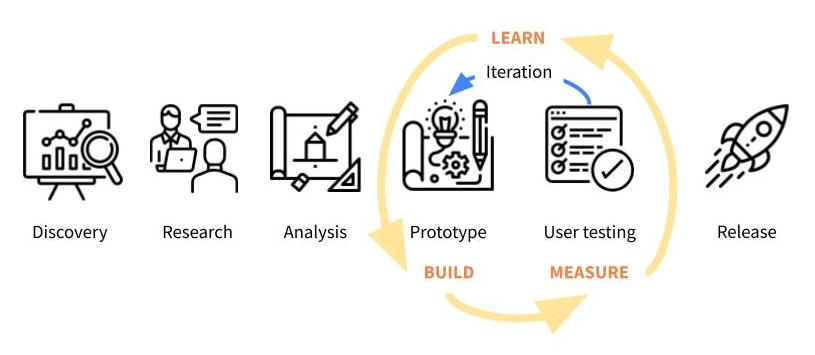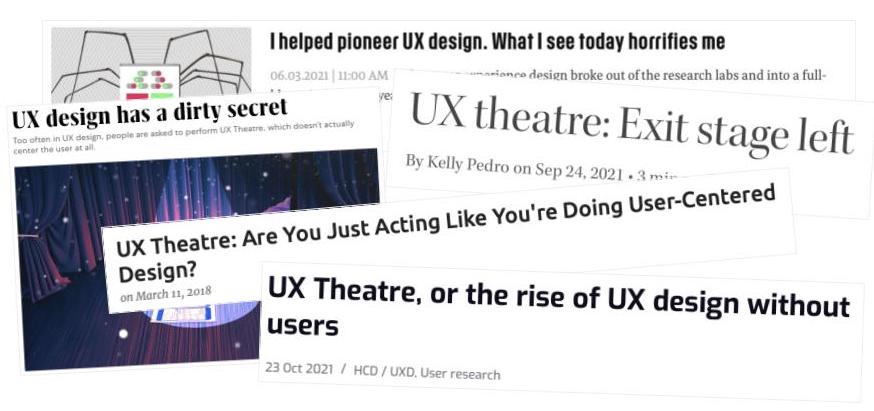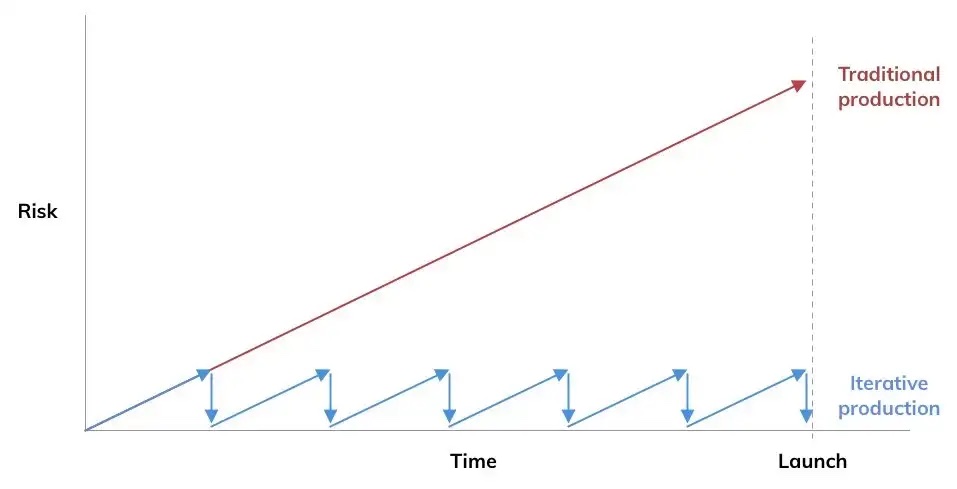
A theatre, but no one’s there… Photo by Kevin Schmid on Unsplash
UX Theatre
Introduction
In my previous post, I stated that a number of large companies fail to follow user-centred production processes, and that by adhering to those processes, you can get ahead of a lot of the competition. As a way of providing more detail to my claims, I’m sharing a talk I previously gave on this very subject, how I discovered that it was enough of a common phenomenon that it actually had a name, how it affects more than just designers, and how everyone on a software production team can work to address it.
The user-centred production process
Everyone who has worked in a project team to produce something should be aware of the User Centred Production process, (also known as User Centred Design, but I prefer to call it a production process, so that it’s more inclusive to non-designers). It’s a valuable mechanism which ensures, by identifying and placing user needs at the centre of production decisions, the resulting product will be successful with users because it addresses those needs. This is a fundamental improvement on previous production methods, which would try and guess what users wanted, build and launch something to address that, and then adjust the product in the next version, or build something else, which could be very time consuming and costly.

(Icons from https://www.flaticon.com/authors/good-ware)
The stages of the process are as follows:
- Discovery – a collaborative exercise to define the aims and scope of the project, giving a rough idea of what is being achieved, and how it will be achieved
- Research – conducting research with people who actually will or currently use the product, to gain insights around their requirements, and ensure that what you plan to build addresses their needs
- Analysis – reviewing what’s discovered during research, highlighting opportunities and problems, identifying user types and their interactions, and noting further questions and assumptions for further research
- Prototyping – quickly creating low fidelity solutions, doing just enough to be able to challenge assumptions and questions, and start a process of slowly improving fidelity as understanding grows, aiming towards a finished product.
- User testing – letting users try the prototype, testing assumptions, asking questions, and providing feedback for further development as part of a “build, measure, learn” cycle.
- Launch – the product can now reach a “minimum viable product” level where it’s ready to ship, and can be widely released. The “build, measure, learn” process can continue, for further refinement and to address further issues.
So why do companies get this wrong?
As previously mentioned, I’ve worked with a number of companies who fail to follow this process, and there are various reasons why this happens. I’ve included them below, with some actual quotes from project leads, justifying why they’re not following the process properly:
Lack of appreciation of the value of the process
“I’ve been in this industry for 15 years, I know what users want, so we don’t need to waste time on research.”
“We don’t need to conduct research, let’s just build something and test it.”
Project leads in this example assume that they don’t need research, and that they can save time and effort by not including it in the production process. This may well be down to a lack of experience of how good research can inform a project. I’ve always found during research that not only does it identify basic needs, which the people above may well be aware of, but there is always something which you didn’t expect – a new discovery, an added benefit, or a “gotcha” moment that changes your perspective. These are impossible to predict, and understanding them can mean the difference between a functional product and a truly great product. Also, in the second quote, by not conducting research before you start building something, you run the risk of building entirely the wrong thing, and wasting time and effort by having to revise it heavily, or scrap it altogether. Research before production ensures that you have a decent understanding of user needs, and have identified opportunities and problems before you begin.
Lack of interest in engaging with users
“We don’t really have connections with our customers, so it’s going to be hard getting people to talk to.”
“Our users are far too busy to engage in research.”
“We would get you some users to talk to, but Sales are far too busy.”
Project teams are often distanced from Sales and Customer Relations in larger companies, and this can sometimes be used as apathy to not engage in user research. I actually heard the first quote while working on a scientific database product, and I detail in my case study about how I had to go out myself and find research candidates, because the project leads were unable to. This friction is usually the cause of project leads being unable to provide links, or scared that if they do, the research will harm sales in some way. A lot of my experience runs counter to this, and having users take part in research, they feel invested in the process and that their requirements are being individually addressed. This can actually help with Sales efforts, and gain useful knowledge that will be beneficial to them.
Time constraints
“I’ve promised that we’ll deliver this product in (x) weeks. We haven’t got time to research or test with users.”
Project leaders stating they haven’t enough time for research indicate more lack of appreciation of the benefits of research. They may not have given time to conduct research because of an adherence to antiquated production techniques that aren’t user centred, or they don’t include time for research because they don’t see its value. Projects should always include time to conduct research as a fundamental part of the user-centred production process, and the concept that research takes a lot of time can be quelled by drawing up research schedules to demonstrate that they fit in the overall project roadmap. Ideally, Agile projects should include continual research, which allows some degree of running research alongside production, although this could introduce the need for some rapid changes of direction if new discoveries are made.
Pressure to deliver
“We can’t pause production to conduct research, we’ve got to start building something immediately!”
It’s understandable that projects have deadlines, as value and progress need to be demonstrated, but the need to build something quickly indicates again that time has not been allocated for research properly. Research should be an important part of initial project planning, and the understanding of its value and the need for allocating time should be made clear to all participants and stakeholders from the start. By doing this, you will ensure that stakeholders will ask to see research discoveries, rather than product progress.
Discovering UX Theatre
After seeing these patterns, I came across a number of articles which indicated that I wasn’t alone in this situation:

These articles led me to the discovery that this term “UX Theatre” had been coined by Tanya Snook in 2018, describing it as:
“the application of any sort of design methodology without including a single user in the process, or including users but merely for show.”
As the my experiences above show, this describes the situation perfectly, and I was even delighted to find that Tanya has not only produced a series of useful blog posts about it, but even a poster to help identify and deal with the situation. I’m greatly indebted to her for such excellent and helpful work.
How does UX Theatre affect projects?
As we’ve previously discussed, missing out on research means that you could start building the wrong thing, but what if you missed out on other parts of the process?
- Missing out on analysis (which often happens if you don’t research, as there’s nothing to analyse) means that you fail to identify opportunities and problems before you start building solutions.
- Missing out on prototyping means that you don’t iterate on your design, and the user doesn’t see it before launch.
- Missing out on testing (which happens if you don’t prototype) means that you increase the risk of the product failing upon launch
This last point is best described in a diagram I saw in a talk by Josh Sieden, co-author of the excellent Lean UX: Designing Great Products with Agile Teams, which has been a fundamental part of my UX learning. In the last slide of his talk, he included this diagram, which describes how continual iterative testing minimises risk in a product production process:

This helps explain the value of iterative testing (a subject I’ve written about before), and how it’s an important part of the user-centred production process, a process which, as indicated above, should be followed fully.
So, what can we do to address this?
The responsibility to identify and address UX Theatre doesn’t just stand with designers, as, demonstrated above, it affects the whole production process and the team. It is here that I invoke one of my favourite film quotes, the inimitable Jeff Goldblum playing Dr Ian Malcolm in Jurassic Park:
Everyone in a production team should be able to challenge the way in which a project is being conducted, and ask for more information about how decisions are being made. To that end, here are some things you can ask:
Check with your team that they’re building the right thing (research)
- Have they provided research and analysis documentation and thinking, to justify their production decisions? Are they based on conversations with actual users, or just assumed?
- Did they write their “as a user…” statements based upon actual research discoveries, or are they just making them up out of what they think is right?
- What other assumptions are being made?
Check with your team that you’re building the thing right (testing)
- Is the project following an iterative “build, measure, learn” process, building a Minimum Viable Product, just high enough fidelity to test, and then rebuild based upon the discoveries made while testing?
- Or are they building a Minimum Sellable Product, which won’t be tested with users until it is launched?
If you can, make sure the project is properly structured
- If you’re part of the initial planning of a project, ensure that the structure of the project includes each of the stages of the user-centred production process above.
- If people question why these sections should be included, provide examples of ways that each stage is useful, and explanations of what could happen if they are omitted.
Conclusion
By identifying and preventing UX Theatre being practised, you’re achieving a number of things:
- Preventing wasting production time and expense by working in an iterative method, being able to identify problems and address them proactively
- Creating products that are more successful, and not only address the needs of users, but also identify ways in which to delight them.
- Reducing frustration in project teams, providing more opportunities for them to learn about users (which can prove useful in future projects), and making products which demonstrate success that they can proud of.
Thank you for reading this through, and for helping to make products and project better!
If you’d like me to help with ensuring success in your products and teams, please get in touch, and we can discuss your needs.